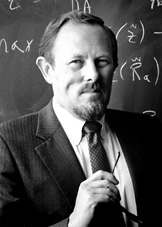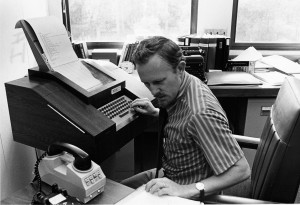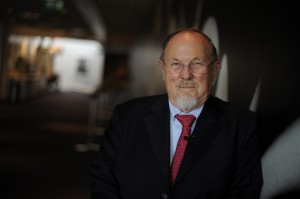Sharper image
William F. Sharpe’s seminal work at the Foster School in the 1960s forever clarified the relationship between risk and return in capital markets, and later earned the Nobel Prize in Economics
 William Sharpe thought he was onto something big.
William Sharpe thought he was onto something big.
No, he knew it. The freshly appointed assistant professor of finance at the Foster School—known as the UW College of Business Administration when he arrived in 1961—had devoted his first years in Seattle to a paper introducing the Capital Asset Pricing Model. On its face, the CAPM was an elegant equation to calculate a security’s expected return. But in its essence, it held the lynchpin of modern investing theory and practice, a luminous primer on the relationship between risk and reward.
If only his editors could see it. Certain of a grand slam off his first swing of the bat, Sharpe submitted his paper to his field’s preeminent journal, anticipating quick congratulations.
Instead, his paper was rejected. Not just once, but twice. It was only on his third try (and third reviewer) that he earned a place in the publication.
And even then, his theory hardly set the finance world ablaze, at least at first.
“When I finally published the paper, I was expecting to receive a flood of calls and correspondence. But they didn’t come,” Sharpe recalls today. “It was really disappointing. I thought, man, this is almost certainly the best paper I’m ever going to write, and nobody cares.”
The disinterest was only temporary. It took a few years for scholars to appreciate the CAPM, and a few more to reach the mainstream of investment advisors. And it took a quarter century for the Nobel Prize committee to recognize what has become a cornerstone of financial economics.
Age of financial enlightenment
Economics had hooked Sharpe from his first semester at UCLA. But his introductory course in investments held no such love-at-first-sight. “There was no underlying theory, no defining principles, no notion of diversification or consideration of risk,” he says. “It was all rules of thumb and how to make a buck.”
That didn’t sit well with a curious young microeconomist. And when he later sought a doctoral dissertation topic, a UCLA finance professor named Fred Weston introduced Sharpe to the work of Harry Markowitz. Working at the RAND Corporation in the 1950s, Markowitz had fused economics and finance to introduce the radical notion of portfolio investing—diversifying across a broad assortment of stocks and bonds to remove the risk that is particular to any one security.
Sharpe was enthralled.
During graduate school at UCLA he joined Markowitz at RAND, and expanded upon the breakthroughs of his unofficial dissertation advisor. Sharpe first applied computer programming and mathematics to cast portfolio theory as an investment strategy. And then he addressed the function of risk on the setting of market prices by those investors, each trying to make money on the market.
The Rainier factor
Sharpe’s introduction to Seattle came one crystalline spring day while on assignment for RAND. As he took in the trim flotillas of sailboats breezing across the waters of Lakes Washington and Union, the lifelong sailor was sold.
“It seemed like an ideal place,” Sharpe says. “I went back to my graduate advisor and asked if he could get me a job at the University of Washington.”
 He did find some time on the water, with the UW Sailing Club. But first and foremost, Sharpe was here to work. He got right to it, first converting his doctoral work implementing portfolio theory into a paper in Management Science.
He did find some time on the water, with the UW Sailing Club. But first and foremost, Sharpe was here to work. He got right to it, first converting his doctoral work implementing portfolio theory into a paper in Management Science.
And then he began writing his defining contribution to financial economics. He worked alone on the paper, but regularly bounced ideas off of faculty neighbors in Mackenzie Hall, including professors Yoram Barzel, Bruce Johnson, Walter Oi, R. Haney Scott and, most notably, George Brabb.
By 1962, Sharpe had a draft of “Capital Asset Prices: a Theory of Market Equilibrium Under Conditions of Risk,” and presented it at several universities to a generally positive reception. But few could have predicted what the CAPM would become.
The model, simplified
As published—finally—in the Journal of Finance in 1964, Sharpe’s paper sparked a dramatic progression from the dark ages of investing.
He started with Markowitz. Specifically, what would happen if everyone did as Markowitz advised—that is, invested in wide-ranging portfolios to diversify away the risks attached to individual securities? How would we price those securities efficiently, given the ever-present risk of just being in the market?
To address the question, Sharpe cast the spotlight on systematic risk—the exposure of a firm to macroeconomic conditions. His measure of this risk is called “beta.” And what he found was that the prices of firms with higher betas tend to move more than the market overall; lower-beta firm prices move less.
The CAPM demonstrates that returns should be proportional to systematic risk, which cannot be removed.
“The first big practical message is that diversifying a portfolio in market proportions is a sensible and efficient market strategy for the average investor,” Sharpe says. “And the second is, yes Virginia, there is a reward, in the form of higher expected returns, for bearing the risk of doing badly in bad times.”
Applicable theory
By the late 1960s, the CAPM had caught on, sparking an entire literature on the topics of risk measurement and asset pricing that continues today.
“Sharpe’s work is the bedrock of finance,” says Rocky Higgins, an emeritus professor of finance who joined the Foster School during Sharpe’s tenure. “It is the start of a great many discussions about corporate and investment finance. We like to think that we’ve advanced, and in many ways we have. But the Capital Asset Pricing Model is still the point from which you might contemplate making advances.”
For his own part, Sharpe authored several subsequent papers while at Foster testing the empirical merits of his theory, including a 1966 mutual fund performance analysis that confirmed the CAPM in practice.
He also fielded increasing calls from firms seeking help implementing the wisdom of portfolio management and the CAPM. He consulted Merrill Lynch in the late 1960s, and later Wells Fargo, Allstate, AT&T, Frank Russell and many others.
In 1968, his stature growing, Sharpe decided to return to the expansive academic environment of the Golden State, where he had spent most of his life. “I never really weaned myself from California,” he says.
He joined UC Irvine briefly, then settled in at Stanford in 1970 for a productive period of research and consulting. He founded his own investment advisory firm in 1986.
Nobel and back again
Early one October morning in 1990, Bill Sharpe was jolted awake by a phone call. A man in a Swedish accent announced that he had been awarded the Sveriges Riksbank Prize in Economic Sciences in Memory of Alfred Nobel, along with Harry Markowitz and Merton Miller. He has yet to find words that adequately describe his feelings upon receiving the ultimate professional honor.
“The Nobel Prize doesn’t change your life among your colleagues much at all, nor should it,” he says. “But it changes everything else.”
Floods of invitations to celebratory lunches, for one, as well as lucrative speaking engagements for all manner of audience.
“It’s fun for a while,” Sharpe reports. “But eventually you find it’s more fun to go back to work.”
 He returned to active duty at Stanford for many productive years. Today he’s the STANCO 25 Professor of Finance, Emeritus. And as his personal and professional interests evolved into retirement economics, in 1996 Sharpe co-founded Financial Engines, provider of retirement investing support to employees of large corporations.
He returned to active duty at Stanford for many productive years. Today he’s the STANCO 25 Professor of Finance, Emeritus. And as his personal and professional interests evolved into retirement economics, in 1996 Sharpe co-founded Financial Engines, provider of retirement investing support to employees of large corporations.
He continues to publish scholarly papers and books. And as he nears his ninth decade, the long-time technophile has become an active blogger (his site, RetirementIncomeScenarios.blogspot.com, is a compendium of his latest evangelical efforts in financial economics and computer programming, his twin passions since the nascent days of both).
CAPM today
About that asset pricing model he introduced to scholars and shareholders 50 years ago… Critics have probed it for flaws ever since. Scholars have scrambled to invent a better way to price securities in the era of Big Data.
Yet the CAPM is still in the text books, and it’s still used daily by corporate and institutional investment managers to plan and assess their portfolios.
Sharpe himself has long tinkered with the model and advocates a different computation of beta now.
“We’ve come a long way since the original Capital Asset Pricing Model,” he says. “But I believe the big messages are still worth paying attention to, if not following entirely. That is, you need to diversify. And if you want to make a reasonable assumption about the expected return of your investments over the long haul, you should be thinking about how badly it would do in bad times. These conclusions hold up.”
Of his scores of published works, did the CAPM paper really turn out to be his best?
“Oh, yes,” says Sharpe’s own toughest critic. “I’ve done other work that might earn an argument, but partly because it includes the essence of the 1964 paper. In terms of something novel and with lasting value, that’s my best.
“…though maybe I write better now.”
Learn what else William Sharpe did while on faculty at Foster.
Read William Sharpe’s investing tips.
1 Response
Leave a Reply
You must be logged in to post a comment.

Indeed, that was the “bedrock of finance”. Some that came later, esp. Merton/Scholes, made things less reliable again, as their own Frankenstein monster, “Long Term Capital Management” 8which had rather a short life span for its name) almost brought down the OECD or world financial system … Thanks for the biographical sketch – I knew him all but in name.